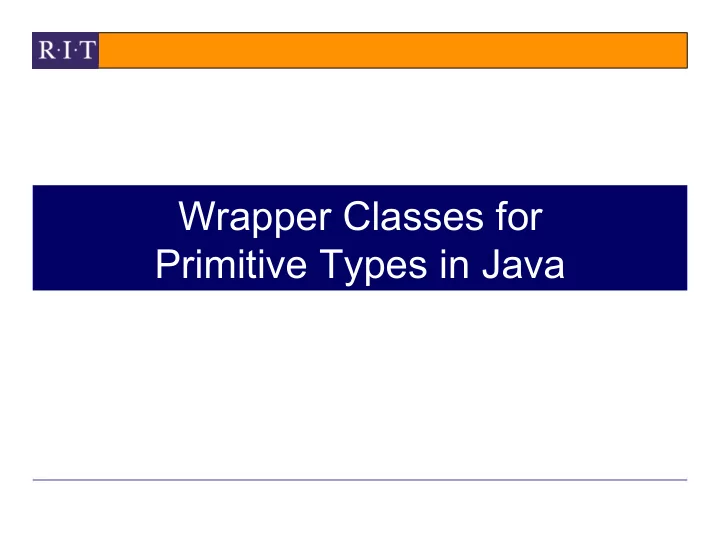

Wrapper Classes for Primitive Types in Java
Primitive Data Types Include... byte, short, int, long, float, double char boolean Q. Why aren’t these objects? A. Efficiency (avoid “object overhead”) - 24 -
Wrapper Classes ...but sometimes it would be useful to have objects hold primitive data. Example To include different primitive data types in a single Object[] array. Wrapper Classes – Classes for “wrapping” primitive data in objects. – All override the Object methods toString, equals, and hashCode. – All wrapper classes (except for Boolean) implement the Comparable interface (implement compareTo()) - 25 -
UML Class Diagram for Wrapper Classes NOTE: all wrapper classes capitalize the name of the associated primitive type, except for Integer and Character. - 26 -
- 27 -
Example: Constructing Wrapped Numbers Double doubleObject = new Double(5.0); Double doubleObject = new Double(“5.0”); Double doubleObject = Double.valueOf(“12.4”) Integer intObject = new Integer(5); Integer intObject = new Integer(“5”); Integer intObject = Integer.valueOf(“12”); NOTE: valueOf is a static method defined for all numeric wrapper classes. - 28 -
Converting Between Strings and Primitive Numeric Types Converting to String Double doubleObject = new Double(5.0); String s = doubleObject.toString(); Converting from String double d = Double.parseDouble(“5.0”); int i = Integer.parseInt(“5”); // Using ‘parse’ method with a radix (base): int j = Integer.parseInt(“11”, 2); // j=3 (in base 10!) - 29 -
Example: A Polymorphic (“Generic”) Sorting Method Text Example, GenericSort.java (implementation of Selection Sort: iteratively finds largest element, places it at the end of the array) • Using the Comparable interface ( compareTo()), different object types are sorted using the same sorting method; each class defines how objects of the class should be ordered. • NOTE: Java defines a static sort in the Arrays class, for any array of objects implementing Comparable • e.g. Arrays.sort(intArray); - 30 -
Automatic Conversion Between Primitive and Wrapper Class Types ‘Boxing’ Converting primitive → wrapper e.g. Integer[ ] intArray = {1, 2, 3}; e.g. Integer intObject = 2; // both legal, ‘autoboxing’ occurs ‘Unboxing’ Converting wrapper → primitive e.g. System.out.println(intArray[0] + intArray[1] + intArray[2]); // int values are summed before output. e.g. int i = new Integer(3); // legal, ‘autounboxing occurs’ Automatic Conversions – Compiler will box for contexts requiring an object – Compiler will unbox for contexts requiring a primitive - 31 -
Recommend
More recommend